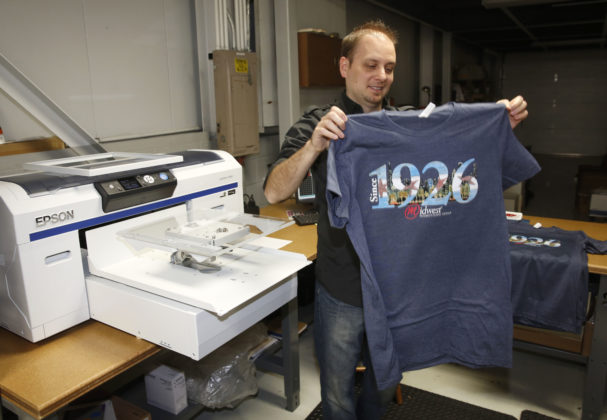Reportedly, more than half of consumers across all age groups own a branded t-shirt, and according to the 2016 Impressions Study, the average number of impressions a t-shirt receives is a remarkable 2,450.
It is no wonder the t-shirt reigns supreme in the promotional products industry. And if you are in a position of purchasing promotional items, a t-shirt likely will be in your future.
There are two main printing methods for t-shirts – direct to garment and screenprinting. There are pros and cons to each depending on your needs.
Let’s take a closer look at each decoration method.
Screenprinting (silk-screening)
Screenprinting is the most widely used for t-shirt printing.
In its simplest form, screenprinting is the process of pushing ink through a porous mesh screen stretched tightly over a metal frame. The image is transferred to the screen either photo-chemically or manually, creating a stencil on the mesh. The screen is placed on top of the garment and, using just the right amount of pressure, a squeegee is dragged across the screen, causing the ink to pass through the stenciled part of the mesh. This process is repeated depending on the number of colors in the design. The garments are then sent through a drying oven or curing system.
If you are using dark garments, you may consider adding an underbase — an additional layer of high-opacity ink (usually white) printed as a “base” on which the other colors sit. This adds a level of brilliance to the design on a dark garment.
Artwork Required For Screenprinting
Vector art is required when screenprinting any job, and all text within the image needs to be converted to outlines and saved as an eps, ai, pdf or svg file. As a caution, just because an image is saved in this file format does not mean it is truly vector art.
Pros
- Cost effective for printing high quantities
- Vibrant colors
- Ability to print on various locations
- Can be used to print on other items such as bags, hats, and jackets
Cons
- More expensive for small quantities
- A screen must be created for every color in the design
- Cost increases as the number of colors increase
- On dark garments more colors means thicker imprint
Direct To Garment Printing (DTG or digital)
The process of direct to garment printing is similar to inkjet printing. Both utilize an ink cartridge which moves back and forth laying ink directly on the shirt. If printing on a dark shirt, it first must go through a pre-treating process, which prepares the shirt to accept the ink. Once printed, the shirt is cured for one minute using a heat press.
Digitally printed apparel has a much softer touch than other methods due to the ink used, and the thin layer of ink that is applied in the process.
Artwork Required For Direct To Garment Printing
Images for direct to garment printing should be clean, sharp, and vibrant. You will be most pleased with the print quality if your image is 300 dpi or higher, sized to fit the garment, and saved as an RGB png file with the background set to transparent. This is not always necessary but good information to keep in mind.
Pros
- Cost effective for printing low quantities
- Prints full digital color
- Able to print detailed images and photographs
- Quick turn-around for small runs
Cons
- Colors are not as vibrant compared to screenprinting
- No volume discounts
- Limited design locations
- Must use 100% cotton shirts
Armed with information and knowledge on both screenprinting and direct to garment printing, but still not certain which to choose? Using a paint analogy, if you were shopping for paint would you want the final outcome to appear matte or semi-gloss? If you chose matte, DTG is for you. If semi-gloss was your pick, you will be happiest with screenprinting.
